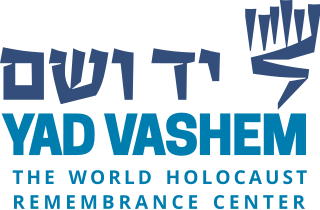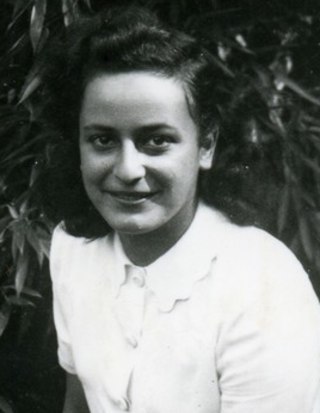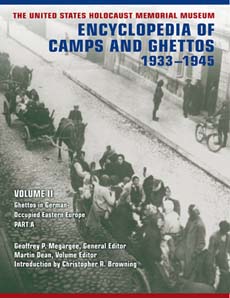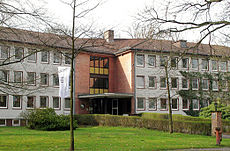
Yad Vashem is Israel's official memorial to the victims of the Holocaust. It is dedicated to preserving the memory of the Jews who were murdered; echoing the stories of the survivors; honoring Jews who fought against their Nazi oppressors and gentiles who selflessly aided Jews in need; and researching the phenomenon of the Holocaust in particular and genocide in general, with the aim of avoiding such events in the future. Yad Vashem's vision, as stated on its website, is: "To lead the documentation, research, education and commemoration of the Holocaust, and to convey the chronicles of this singular Jewish and human event to every person in Israel, to the Jewish people, and to every significant and relevant audience worldwide."
This is a selected bibliography and other resources for The Holocaust, including prominent primary sources, historical studies, notable survivor accounts and autobiographies, as well as other documentation and further hypotheses.

Vergangenheitsbewältigung is a German compound noun describing processes that since the later 20th century have become key in the study of post-1945 German literature, society, and culture.

Holocaust Memorial Day is a national commemoration day in the United Kingdom dedicated to the remembrance of the Jews and others who suffered in the Holocaust, under Nazi persecution. It was first held in January 2001 and has been on the same date every year since. The chosen date is the anniversary of the liberation of Auschwitz concentration camp by the Soviet Union in 1945, the date also chosen for the International Holocaust Remembrance Day and some other national Holocaust Memorial Days.

The Holocaust Memorial Center in Farmington Hills, Michigan, near Detroit, is Michigan's largest Holocaust museum.

Nazi plunder was organized stealing of art and other items which occurred as a result of the organized looting of European countries during the time of the Nazi Party in Germany.

The Arolsen Archives – International Center on Nazi Persecution formerly the International Tracing Service (ITS), in German Internationaler Suchdienst, in French Service International de Recherches in Bad Arolsen, Germany, is an internationally governed centre for documentation, information and research on Nazi persecution, forced labour and the Holocaust in Nazi Germany and its occupied regions. The archive contains about 30 million documents from concentration camps, details of forced labour, and files on displaced persons. ITS preserves the original documents and clarifies the fate of those persecuted by the Nazis. The archives have been accessible to researchers since 2007. In May 2019 the Center uploaded around 13 million documents and made it available online to the public. The archives are currently being digitised and transcribed through the crowdsourcing platform Zooniverse. As of September 2022, approximately 46% of the archives have been transcribed.

Czesława Kwoka was a Polish Catholic girl who was murdered at the age of 14 in Auschwitz. One of the thousands of minor child and teen victims of German World War II war crimes against ethnic Poles in German-occupied Poland, she is among those memorialized in an Auschwitz-Birkenau State Museum exhibit, "Block no. 6: Exhibition: The Life of the Prisoners".
Holocaust survivors are people who survived the Holocaust, defined as the persecution and attempted annihilation of the Jews by Nazi Germany and its allies before and during World War II in Europe and North Africa. There is no universally accepted definition of the term, and it has been applied variously to Jews who survived the war in German-occupied Europe or other Axis territories, as well as to those who fled to Allied and neutral countries before or during the war. In some cases, non-Jews who also experienced collective persecution under the Nazi regime are considered Holocaust survivors as well. The definition has evolved over time.
Holocaust victims were people targeted by the government of Nazi Germany based on their ethnicity, religion, political beliefs, disability or sexual orientation. The institutionalized practice by the Nazis of singling out and persecuting people resulted in the Holocaust, which began with legalized social discrimination against specific groups, involuntary hospitalization, euthanasia, and forced sterilization of persons considered physically or mentally unfit for society. The vast majority of the Nazi regime's victims were Jews, Sinti-Roma peoples, and Slavs but victims also encompassed people identified as social outsiders in the Nazi worldview, such as homosexuals, and political enemies. Nazi persecution escalated during World War II and included: non-judicial incarceration, confiscation of property, forced labor, sexual slavery, death through overwork, human experimentation, undernourishment, and execution through a variety of methods. For specified groups like the Jews, genocide was the Nazis' primary goal.

Hélène Berr was a French Jewish woman, who documented her life in a diary during the time of Nazi occupation of France. In France she is considered to be a "French Anne Frank". She died from typhus during an epidemic of the disease in Bergen-Belsen concentration camp that also killed Anne Frank and her sister Margot.

The Holocaust in Latvia refers to the crimes against humanity committed by Nazi Germany and collaborators victimizing Jews during the occupation of Latvia. From 1941 to 1944, around 70,000 Jews were murdered, approximately three-quarters of the pre-war total of 93,000. In addition, thousands of German and Austrian Jews were deported to the Riga Ghetto.
The Jelgava massacres were the killing of the Jewish population of the city of Jelgava, Latvia that occurred in the second half of July or in early August 1941. The murders were carried out by German police units under the command of Alfred Becu, with a significant contribution by Latvian auxiliary police organized by Mārtiņš Vagulāns.

The Holocaust in the Netherlands was organized by Nazi Germany in occupied Netherlands as part of the Holocaust across Europe during the Second World War. The Nazi occupation in 1940 immediately began disrupting the norms of Dutch society, separating Dutch Jews in multiple ways from the general Dutch population. The Nazis used existing Dutch civil administration as well as the Dutch Jewish Council "as an invaluable means to their end".
The Sarny massacre was the execution of an estimated 14,000-18,000 people, mostly Jews, in the Nazi-occupied Polish city of Sarny on August 27-28, 1942.
Rudolf Robert was a German-Jewish survivor of the holocaust and a Gabbai of the Jewish community of Berlin.

Encyclopedia of Camps and Ghettos, 1933–1945 is a seven-part encyclopedia series that explores the history of the concentration camps, ghettos, forced-labor camps, and other sites of detention, persecution, or state-sponsored murder run by Nazi Germany and other Axis powers in Europe and Africa. The series is produced by the United States Holocaust Memorial Museum (USHMM) and published by Indiana University Press. Research began in 2000; the first volume was published in 2009; and the final volume is slated for publication in 2025. Along with entries on individual sites, the encyclopedias also contain scholarly overviews for historical context.
The Holocaust in Austria was the systematic persecution, plunder and extermination of Jews by German and Austrian Nazis from 1938 to 1945. Part of the wider-Holocaust, pervasive persecution of Jews was immediate after the German annexation of Austria, known as the Anschluss. An estimated 70,000 Jews were murdered and 125,000 forced to flee Austria as refugees.
The Gedenkbuch – Opfer der Verfolgung der Juden unter der nationalsozialistischen Gewaltherrschaft 1933–1945 is a memorial book published by the German Federal Archives, listing persons murdered during the Holocaust as part of the Nazis' so-called "Final Solution". It is limited to people, regardless of nationality, who voluntarily lived within the borders of the German Reich as of December 31, 1937. Since 2007, it has been available online. As of February 2020, it contained 176,475 names. Alongside the Arolsen Archives and Yad Vashem's central database, it is considered an important resource for Holocaust research. Since its publication, many cities and states have published their own memorial books, complementing and expanding on the Gedenkbuch.











